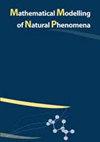A NUMERICAL 3D FLUID-STRUCTURE INTERACTION MODEL FOR BLOOD FLOW IN A MRI-BASED ATHEROSCLEROTIC ARTERY
IF 2.1
4区 数学
Q2 MATHEMATICAL & COMPUTATIONAL BIOLOGY
引用次数: 0
Abstract
Atherosclerosis, as a result of an inflammatory process, is the thickening and loss of elasticity of the walls of arteries that is associated with the formation of atherosclerotic plaques within the arterial intima, which present a double threat. A piece of vulnerable plaque can break off and be carried by the bloodstream until it gets stuck; and plaque that narrows an artery may lead to a thrombus that sticks to the blood vessel's inner wall. The purpose of the present article is to compare effects across different atheromatous plaque material assumptions on hemodynamics and biomechanics within a partly patient-specific computational domain representing an atherosclerotic artery. A full scale 3D FSI numerical model is implemented and different material hyperelastic assumptions are considered for comparison purposes. The 3D realistic geometry is reconstructed from a medical image. This technique may be useful, specially with the recent advances in computer-aided design (CAD), medical imaging, and 3D printing technologies that have provided a rapid and cost efficient method to generate arterial stenotic biomodels, making in vitro studies a valuable and powerful tool. To understand our results, hemodynamic parameters and structural stress analysis were performed. The results are consistent with previous findings.基于mri的动脉粥样硬化血流的三维流固耦合模型
动脉粥样硬化是炎症过程的结果,是动脉壁增厚和弹性丧失,与动脉内膜内动脉粥样硬化斑块的形成有关,这具有双重威胁。一块脆弱的斑块可能会脱落,并被血液携带,直到它被卡住;而使动脉变窄的斑块可能会导致粘在血管内壁的血栓。本文的目的是比较不同的动脉粥样硬化斑块材料假设对血流动力学和生物力学的影响,在一个部分患者特异性的计算域内代表动脉粥样硬化动脉。实现了一个全尺寸的三维FSI数值模型,并考虑了不同的材料超弹性假设进行比较。从医学图像中重建三维真实几何体。这项技术可能是有用的,特别是随着计算机辅助设计(CAD)、医学成像和3D打印技术的最新进展,这些技术提供了一种快速、经济高效的方法来生成动脉狭窄的生物模型,使体外研究成为一种有价值和强大的工具。为了理解我们的结果,我们进行了血流动力学参数和结构应力分析。研究结果与之前的发现一致。
本文章由计算机程序翻译,如有差异,请以英文原文为准。
求助全文
约1分钟内获得全文
求助全文
来源期刊

Mathematical Modelling of Natural Phenomena
MATHEMATICAL & COMPUTATIONAL BIOLOGY-MATHEMATICS, INTERDISCIPLINARY APPLICATIONS
CiteScore
5.20
自引率
0.00%
发文量
46
审稿时长
6-12 weeks
期刊介绍:
The Mathematical Modelling of Natural Phenomena (MMNP) is an international research journal, which publishes top-level original and review papers, short communications and proceedings on mathematical modelling in biology, medicine, chemistry, physics, and other areas. The scope of the journal is devoted to mathematical modelling with sufficiently advanced model, and the works studying mainly the existence and stability of stationary points of ODE systems are not considered. The scope of the journal also includes applied mathematics and mathematical analysis in the context of its applications to the real world problems. The journal is essentially functioning on the basis of topical issues representing active areas of research. Each topical issue has its own editorial board. The authors are invited to submit papers to the announced issues or to suggest new issues.
Journal publishes research articles and reviews within the whole field of mathematical modelling, and it will continue to provide information on the latest trends and developments in this ever-expanding subject.
 求助内容:
求助内容: 应助结果提醒方式:
应助结果提醒方式:


